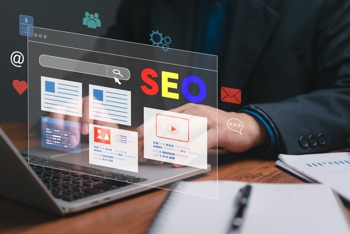
What is "charity SEO"?
Charity SEO is simply applying SEO best practice with a nonprofit lens. The fundamentals are the same as for any organisation - keywords, content, links, technical setup - but the goals are a little different:
-
People aren’t looking for products, they’re searching for support, causes, or ways to give back.
-
Trust is critical. Google rewards content that shows you’re credible and authoritative. For charities, that means clear information about who you are, your impact, and your transparency.
When I was working in the sector, we didn’t have an SEO manager or a big agency on tap. We started with small wins: cleaning up page titles, refreshing donation page content, making sure our images had proper alt text. Honestly? Those basics made a huge difference.
What is Generative Engine Optimisation?
The new kid on the block, GEO is SEO's new playmate.
Search is changing. Increasingly, people don’t just “Google” things, they ask AI-driven tools (like ChatGPT or Copilot). These tools don’t just show links, they generate answers.
So what does that mean for charities?
- If you want AI assistants to mention your campaigns, your content needs to be clear, structured, and answer direct questions.
- Write in a Q&A format - just like this article. AI tools lift those concise answers and surface them.
- Be factual, transparent and trustworthy, too. AI systems pull from sources they consider credible. Cite data, reference official bodies, and avoid vague claims.
- Think conversationally: use the words supporters actually type or say (e.g. “How can I donate to a hospice in Bristol?”).
In short: SEO gets you found in Google, GEO gets you found in AI answers. Charities can really benefit from doing both.
How can charities get started with SEO (and GEO)?
Step 1. Start with keywords
Before you can optimise anything, you need to know what your audience is searching for. Think about the real questions people are asking, such as:
- “How can I volunteer at a food bank near me?”
- “Best UK charities for wildlife conservation”
- “Bereavement support in Manchester”
Free tools like Google Keyword Planner can help, but don’t underestimate the power of simply talking to your supporters. They’ll tell you the phrases they actually use.
Step 2. Optimise your key pages
Once you know your keywords, it’s time to put them to work. Here’s how to optimise your most important pages:
Title tags & meta descriptions
These are the first things people (and Google) see in search results, so they matter.
- Title: 50-60 characters, include your main/primary keyword
- Meta description: 120–155 characters summarising what the page offers.
Tool tip: Getting this right doesn’t have to be complicated. Access Raise includes several powerful SEO features designed for charities, giving you full control over meta titles, meta descriptions and image alt-text. It even has built-in AI built tools that can do it for you!
“Having Evo’s AI tools is like having an extra pair of hands. They save us time, boost confidence in our content, and mean we don’t have to be experts in everything. It’s a game-changer for a small team.”
- Jill Haines, Marketing and Communications Manager, FTCT (read their story)
Headings
Good headings make your content easier to scan and help search engines understand what your page is about.
- Use one clear H1 per page.
- Break content into H2s/H3s that mirror questions (e.g. “How can I donate to your charity?”).
Body content
This is where you deliver the value, and it's critical to charity SEO. Keep it natural, useful and supporter-focused.
- Answer the main question within the first 100 words.
- Use natural, conversational language.
- Add facts and context - AI and Google both value specifics.
Images & alt text
Images tell your story visually, and alt text makes sure search engines (and screen readers) understand them.
- Use meaningful images (campaign shots, event photos).
- Add descriptive alt text that includes a keyword naturally.
Tool tip: Access Raise has built-in accessibility tools, so you can be sure your content is accessible to all supporters.
Internal and external links
Links help users and search engines navigate your site and validate your authority.
- Link your campaign pages to donation or volunteer info.
- Reference credible external sources (e.g. ONS, NHS, Charity Commission).
Mobile & speed
Most supporters will visit your site on their phone, so speed and usability are non-negotiable.
- Ensure your site is responsive.
- Run a quick Google PageSpeed test and fix anything slowing you down.
Step 3. Build trust and authority
SEO isn’t just about your site, it’s about how the wider web sees you. Building authority takes time, but small, consistent actions pay off:
- Share case studies and impact stories.
- Encourage partner organisations to link back to you.
- Get your voice heard in local press or sector blogs.
Step 4. Track and tweak
The final step is about measuring your progress. Tracking lets you see what’s working and where to improve. Use free tools like Google Search Console to track which keywords are bringing people to your site.
Keep an eye on:
-
Organic traffic trends
-
Keyword rankings
-
Click-through rates from Google
-
Conversions (sign-ups, donations, campaign actions)
Checking this monthly can give you a real buzz - it should show your hard working paying off!
GEO-friendly content tips
Want to give AI a helping hand to surface your charity? Try this:
- Use questions as headings.
- Answer them in one or two sentences, then expand.
- Add facts and numbers where possible.
- Refresh content regularly to stay relevant.
How do links improve charity SEO?
In short, they help you climb search engine rankings.
The quickest and easiest links are internal links that take visitors to other pages on your website, or to external sites and sources. These show Google that your site is genuine, and your content is connected.
Don’t stop there, though. If you really want to hit top spot, think backlinks ...
That's when other credible websites link back to yours. Don't be tempted to pay for this - Google knows all the tricks. Ultimately, it makes more sense to get fewer links from high-quality, relevant websites, than lots of paid links from random ones.
Final takeaway
SEO (and now GEO) can feel like a rabbit hole, but you don’t have to do everything at once. Even small, simple changes - like refreshing your top three campaign pages - will help.
Start small. Be consistent. Think like your supporters.
We look forward to seeing you on Google! If you need any advice in the meantime, get in touch with our experts.

 AU & NZ
AU & NZ
 SG
SG
 MY
MY
 US
US
 IE
IE
